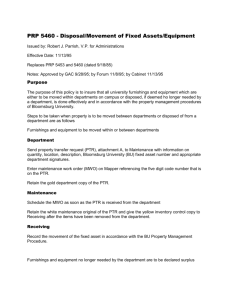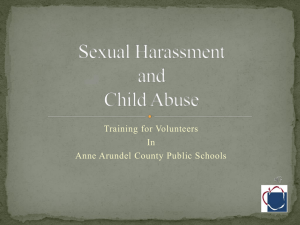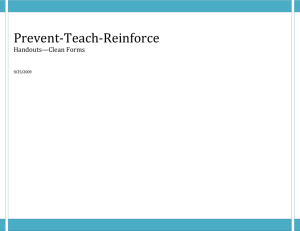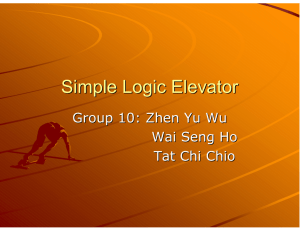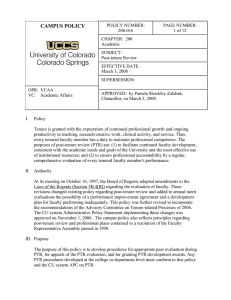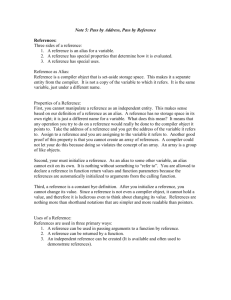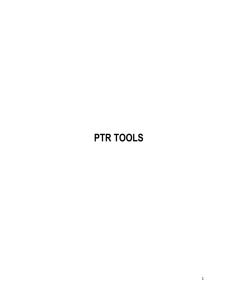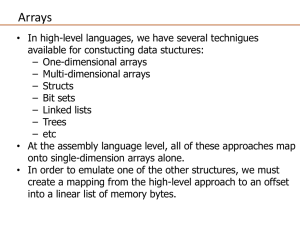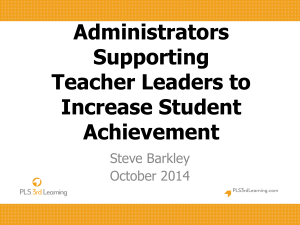10.10_challenging_behaviors - tacsei
advertisement
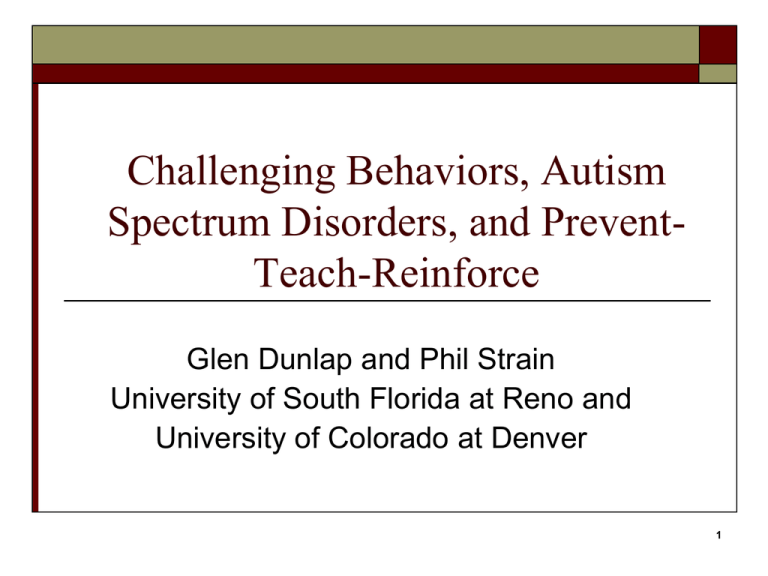
Challenging Behaviors, Autism Spectrum Disorders, and PreventTeach-Reinforce Glen Dunlap and Phil Strain University of South Florida at Reno and University of Colorado at Denver 1 Purpose of Presentation Describe a multi-tiered framework for addressing challenging behaviors --- including challenging behaviors of children with ASD Present an overview of individualized interventions – positive behavior support Describe a tertiary model for addressing the most serious challenging behaviors: “Prevent-TeachReinforce (PTR)” Model description and research 2 Challenging Behaviors Destructive Behaviors Disruptive Behaviors Long tantrums; Loud, Repetitive Noises; Running, etc. Irritating & Interfering Behaviors Aggression; SIB; Property Destruction Repetitive and perseverative speech or actions, cursing, inappropriate touching, etc. Social Withdrawal Lack of responsivity and initiations 3 Importance of Challenging Behaviors Barrier to Inclusion, Community Participation, and Social Opportunities Most Significant Impediment to Education Present Physical & Emotional Risk for Individual and for Families, Teachers, Other Professionals, Peers and Friends --------------Need to Prevent/Resolve Challenging Behaviors as Early and as Thoroughly as Possible 4 A Model of Prevention of Challenging Behaviors for Young Children The Pyramid Model Technical Assistance Center for Social Emotional Interventions (TACSEI) www.challengingbehavior.org Multi-tiered Prevention Frameworks Increasingly common in community and behavioral health disciplines (e.g., SW-PBS) Basic framework has 3 levels: (1) Universal strategies (primary prevention)--- for everybody; low intensity prevention practices (2) Targeted strategies (secondary prevention) --- for particularly high risk groups; higher intensity (3) Indicated strategies (tertiary prevention/intervention)--- for individuals already affected by problem; usually intensive and individualized strategies 6 Pyramid Model (Fox, Dunlap, Hemmeter, Joseph, & Strain, 2003) Tertiary Intervention Secondary Prevention Universal Promotion Preventing Challenging Behavior for Children with ASD LEVEL 3: Individualized Intensive Interventions LEVEL 2: Building social and communicative competencies inconsistent with problem behavior LEVEL 1: Building positive relationships, supportive environments, and health physiologies Prevention – Universal (Level 1) Positive Relationships Nurturing, secure, stimulating, instructional Enhances influence of adult caregiver Physical and Emotional Health Physical health and nutrition Social-emotional well being Safe, responsive, friendly, stimulating and comprehensible environment 9 Prevention – Level 1 Practices High quality environment Adult-child interactions Structure, routine, schedule, predictability Positive attention Ongoing instruction Useful communication Social skills Clear, consistent behavioral expectations 10 Level 2 Prevention Practices Differences from Level 1 Practices Intensity of Intervention Planfulness of Intervention Intensity of Data Collection Intensity of Family Involvement For children at high risk for problem behavior: Parent training classes Social-emotional teaching curricula 11 Building Functional Competencies Interventions focused on teaching and building appropriate engagement Intervention supports for enhancing motivation e.g., Pivotal Response Training for children with ASD Group strategies (classroom models) with direct focus on teaching and motivating social interaction 12 Level 3 (Tertiary) Practices Intensive Individualized Interventions Are used for children with persistent and severe problem behavior - when children do not respond to preventive practices, child guidance procedures (e.g., redirection), or social-emotional teaching strategies Are used with children who have multiple and severe risk factors Intellectual-Communicative Disability (e.g., autism) Positive behavior support 13 General Approach - PBS Teaming, Planning Goal Setting; Definition of Roles Functional (Behavioral) Assessment Development of Behavior Support Plan Implementation and Evaluation of BSP 14 Core Elements of a Behavior Support Plan (Linked to Assessment Information) Prevention Strategies – Arrangements of antecedent environment Teaching Strategies – Building skills to teach throughout the day to replace the problem behavior Reinforcers – Providing effective reinforcement schedules (contingency management) ----------------+ Evaluation strategies 15 Prevent-Teach-Reinforce A Standardized and Individualized Model For School-based Interventions A Practical Model of Positive Behavior Support 16 Why P-T-R? We’ve known about functional assessment and assessment-based interventions for more than 20 years. And we’ve conducted many, many trainings on PBS for serious behavior problems for a long time. And this is well and good, however…. We see optimal outcomes too rarely A big concern involves insufficient implementation of PBS procedures of assessment, intervention and data collection. A problem of implementation fidelity. 17 Purpose of P-T-R To provide schools with a standardized, easyto-use model with which to apply researchbased, behavioral strategies for addressing the most serious problem behaviors of students. For all students with serious problem behaviors -- special education, general education. Intended for pre-K through high school Most research to date has been conducted in grades K-8 18 PTR Model Research-based Practices Assessment and Intervention Team-driven decision-making Steps are scripted as much as possible Each step ends with self-evaluation (checklist) Selection of interventions is menu-driven Entire process is manualized 19 The PTR Model 5-Step Process Developing a Team Establishing clear goals (short and long term) Functional Assessment Designing and Implementing a Behavior Intervention Plan Evaluation (ongoing) and Revision (as necessary) 21 Step 1: Teaming Purpose: Establish group involved with developing and implementing intervention Members: Teacher(s), Para-educator(s), School professionals, Family members, etc. 3-8 individuals At least one administrator who can deliver resources and develop/interpret policies At least one person knowledgeable in behavioral theory and principles and experienced in FA and BIP 22 Step 2: Goal Setting and Data Collection Purpose: (1) to establish clear long and short-term objectives; (2) to establish a unified vision for desired outcomes; (3) establish feasible strategies for valid data collection Kinds of goals: (1) Reducing specified problem behaviors; (2) Develop academic competencies; (3) Improve social competencies, problem solving, and interpersonal relations/interactions 23 Data Collection Data instrument(s) decided by team Recommendations are often for Behavior Rating Scales – Usually 5-point scales with specific anchors indicating frequencies, durations, and/or intensities of problem behavior 24 Step 3: Functional Assessment Purpose: Identify function(s) and antecedent variables influencing target behavior(s) Strategy: (1) Detailed, structured questionnaires for each team member focused on antecedent variables, functions, and maintaining consequences. (2) Team meeting to produce consensus. Outcomes: Hypothesis statement(s) with each component specified. 25 Examples of Assessment Questions: “Prevent” 1. Are there times of the day when problem behavior is most likely to occur? If yes, what are they? 1a. Are there times of the day when problem behavior is least likely to occur? If yes, what are they? 2. Are there specific activities (for example, independent work, arithmetic, recess, transitions) that problem behavior is very likely to occur? What are the activities? 2a. Are there specific activities (for example, independent work, arithmetic, recess, transitions) that cooperative and prosocial behavior is very likely to occur? What are the activities? 26 Examples of Assessment Questions: “Teach” 1. Does the problem behavior seem to be exhibited in order to gain attention from peers? If so, are there specific peer(s) whose attention is solicited? 2. Does the problem behavior seem to be exhibited in order to gain attention from adults? If so, are there particular adult(s) whose attention is solicited? 3. Does the problem behavior seem to be exhibited in order to obtain objects (toys, materials, food) from peers or adults? If so, what objects are solicited? 27 Step 4: Intervention Design and Implementation Purpose: To build a Behavior Intervention Plan (BIP) based on FA information Features: (1) BIP must include at least one strategy from each of the 3 components: Prevent, Teach, Reinforce (2) Menus of research-based strategies for each component; forms and templates to build plan (3) Selection of strategies is made by team, based on FA and on team’s ability/resources to implement 30 Step 5: Evaluation Purpose: (1) Measure effects of intervention on problem behaviors and academic/social behaviors (progress monitoring); (2) Measure fidelity of implementation Features: Simple (easy-to-use) instruments --behavior rating scales; checklists; etc. 31 Research on PTR Randomized Control Group Evaluation Case Study (A-B) Analyses Including students with ASD Behavior rating scale (BRS) data Direct observation data Multiple Baseline Across Participants (with ASD) Design 32 A Randomized Controlled Evaluation of PTR Iovannone, Greenbaum, Wang, Kincaid, Dunlap, & Strain, (2009), Journal of Emotional and Behavioral Disorders, 17, 213-225 33 Participants N = 245 students Randomly assigned to PTR or Services as Usual Nominated as the students with the most serious problem behaviors in their class Grades K-8; from 5 school districts in FL and CO Ages 4-15 (X = 8.17) 48% had IEPs; 33% in self-contained special education programs Variety of Disability labels, including ASD (N = 25) 50% White; 29% Hispanic; 18% African American 38% on free or reduced-price lunch programs 34 Procedures All Assessment and Intervention Steps Carried out by School-based Teams Almost all interventions conducted by students’ teachers Process facilitated by PTR research staff and implementation manual Data collected by Teachers and by PTR staff 35 Principal Measures Social Skills Rating System (SSRS) Problem Behavior subscale Social Skills subscale Academic Engaged Time Social Validity (Treatment Acceptability Rating Form; Reimers and Wacker) Fidelity of Implementation 36 Results Social Skills --- Difference in standard scores from baseline to post-test: Problem Behavior --- Difference in standard scores from baseline to post-test: PTR = + 7.38; SAU = + 1.25 (p < .001) PTR = - 5.30; SAU = - 0.76 (p < .001) Academic Engaged Time --- Difference in rates from baseline to post-test: PTR = + 0.13; SAU = + .02 (p < .001) 37 Fidelity: Data showed that almost all teachers (> 80%) were able to implement the intervention plans with high fidelity Social Validity: Data on the TARF showed that teachers found the PTR process to be highly acceptable and efficacious. Teachers were very willing to use the PTR process in the future. 38 Time Series Analyses 1) BRS case study data - From Dunlap et al (2010; JPBI) 2) Multiple baseline across participants w/ ASD - From Strain, Wilson, & Dunlap (under review) 39 Behavior Rating Scales 5-point scales Anchors specify amplitude on relevant dimension (frequency, duration, intensity) Teachers and school-based teams define behaviors and anchors on individual basis Scales completed retrospectively at end of each session 40 Teacher’s Ratings of Mike’s Behavior PTR intervention Baseline Disruptive Behavior 5 4 3 2 Disruptive Behavior 1 Engagement 5 4 3 2 Engagement 1 Task Completion 5 4 3 2 Independent Task Completion 1 5 10 15 20 25 Sessions 34 39 44 49 Teacher’s ratings of Jose’s Behavior Baseline PTR Intervention 5 Following Directions 4 Following Directions 3 2 1 5 Appropriate Interactions 4 3 Times to Interact 2 1 5 Off Task Behavior Off Task 4 3 2 1 1 2 3 4 5 6 7 8 9 10 11 12 13 14 15 16 17 18 19 20 21 22 23 Sessions Multiple Baseline Analysis Participants 3 students with ASD; Josh, Alex, Rosalie Kindergarten; Grade 2; Grade 4 Cognitive functioning = Typical to mild delay All had verbal language, but often not used effectively Majority of time in general education classes All had frequent problem behaviors, and were identified as students with most serious problems in their classes property destruction; disruptive behavior, outbursts, crying, some aggression 43 Procedures Baseline (services as usual) PTR = Independent Variable Data for study obtained from video recordings Teaming, goal setting, data collection (BRS) PTR (Functional) Assessment Individualized Behavior Intervention Plans 15 minute sessions in regular classroom context 10-second time samples % of samples with occurrence of behavior Dependent Variables Problem Behavior Engagement 44 Behavior Intervention Plans JOSH P = explicit expectations on card T = instruction on expectations; self-management R = self-recruited SR+; praise for following expectations; “tokens” with stickers/treasures as back ups ALEX P = written schedules T = self-management (using lists for independent responding) R = sea shells + time to examine his sea shells 45 BIPs (continued) Rosalie explicit expectations/instructions for social interaction instruction on social interactions; problem solving; and self-monitoring (journal) “CIA (caught in the act)” credits 46 Problem Behavior (% Intervals) Josh Alex Rosalie Engagement (% Intervals) Josh Alex Rosalie Conclusions 49 In a large RCT, the PTR process has been shown to be effective, when implemented by typical, schoolbased teams, in: reducing problem behavior and increasing social skills and academic engaged time compared to “services as usual.” PTR was also shown to be implemented with fidelity by teachers approved by Data have also shown PTR to be effective when applied with students with autism (multiple baseline analysis) 50 However, PTR has not yet been demonstrated in conditions without “expert” facilitators In addition, there are students for whom PTR was not as effective as we would like… and we have yet to examine the (mediating) conditions under which the process is more (and less) effective. 51 For young children… PTR has been used often with children aged 4-6, but there has been no systematic research in preschool or toddler programs (yet) A version of the PTR manual for young children is in development, and pilot research in pre-K settings will commence in January 52
